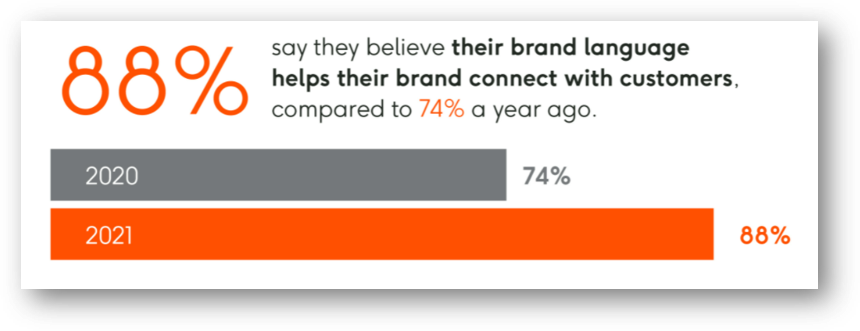
How often does your station review its positioning language?
How frequently do you freshen the production?
Do you test the language you use on and off the air?
Don’t feel bad. Most stations couldn’t pass this test, nor could most companies doing business in the marketplace.
But a growing number are becoming cognizant of the messaging they send with the specific words in their slogans, their positioning statements, and their marketing messages. That’s according to a new study from Phrasee, conducted among 300 senior marketers at large organizations. Participants came from a wide variety of industries, including ecommerce. telecom, banking, finance and travel/hospitality.
Bottom line? Marketers are putting more weight on brand language. Overall, nine in ten (91%) concur its a core part of their strategic outreach. And a similar percentage (88%) indicate brand language is a connection tool (up from 74% last year).

Why the shift? It may have something to do with the increasing importance of SEO and AI – tools that are heavily reliant on what you say and how you say it.
Interestingly, these marketers struggle with some of the same challenges as radio programmers and promotion managers:
- Keeping positioning language and promos in-sync with current events

- Struggling to keep marketing messages interesting and engaging
- Ensuring the tone is right
- Dealing with a lack of resources that get in the way of creative energy
How do they know their messaging strikes a responsive chord with their target audience? Most don’t. It turns out that just like in radio, brands aren’t doing enough to test, adapt, and optimize marketing messages.
Interestingly, only one in four conducted testing among customers. And three in ten (31%) complain top management doesn’t support these efforts to dig deeper to determine the language and phrasing that works best.
 So, a lack of both data and A:B copy testing (to determine which version works best) are at the core of the problem. That said, Phrasee learned more marketers are trusting AI can help them create optimal brand language.
So, a lack of both data and A:B copy testing (to determine which version works best) are at the core of the problem. That said, Phrasee learned more marketers are trusting AI can help them create optimal brand language.
When radio’s only delivery platform was broadcast, only perceptual research could deliver answers to key questions about slogans, positioning language, and product claims. It was expensive, time-consuming, and it took away from other key questions – like music, personalities, and perceptions.
Thanks to digital distribution platforms- especially email and mobile apps – radio station marketers can better evaluate how brand language impacts open rates, message consumption, and actions taken. And they can do it quickly and cost-effectively.
Phrasee CEO Parry Malm puts the shift this way: “The penny has finally dropped about the importance of brand language as more and more brands focus on developing their unique voice. The challenge marketers face now is optimizing and scaling their brand language for maximum impact across the customer journey, all while staying true to that unique voice.”
focus on developing their unique voice. The challenge marketers face now is optimizing and scaling their brand language for maximum impact across the customer journey, all while staying true to that unique voice.”
Radio broadcasters are facing major time crunches, exacerbated by multi-responsibilities, lower head counts, and diminishing budgets. And yet, stale tired promos and drops that have been on the air for months (years?) have likely reached a point where they’re ineffective, if not completely ignored. Freshening up station positioning, feature language, and personality promotion is essential to sounding current.
Email database testing is a simple, fast, and economical solution to pressure-testing the nuances of brand language.
Before putting it on the air – or on a billboard, direct mail piece, or TV spot – radio marketers would be wise to run it up the consumer flagpole via digital channels.
If you know, you know.
So, what’s in a word?
Plenty.
To download the Phrasee study, click here.
To download Phrasee’s infographic, click here.
- Media And Technology In 2025: Believe It Or Not! - April 18, 2025
- In Radio, You Just Never Know - April 17, 2025
- The Secret To Making A Great Podcast (And Great Radio) - April 16, 2025




I miss the voice work and writing skills of Nick Michaels more than ever.
I do, too. Nick was the master. I always felt like I was coming up short when I heard him explain the power of Classic Rock.
In 2021, do ya think radio is spending too much time on “imaging” and not enough time on relating ? You say updating the imaging can help a station be “current” when the air talent can do that every day! Do you think that too much of the “heavy lifting” is being assigned to Joe Cipriano, Howard Cogan, Charlie Van Dyke and the rest? These great enthusiastic voices should (imho) be reserved for the special events-and staging the local talent to finish the job. Johnny Gilbert has been announcing “Jeopardy” for decades, and hasn’t had to ask one “answer”. Imaging is great-but every time the jock opens his/her mouth-they’re “imaging” and positioning the product. They SHOULD (with proper planning) do a much better and more convincing job. That way “imaging” and positioning can be updated on a daily basis. Just like your amazing blog posts, Fred.
Some great points here, Dave, that I hope readers will take to heart. Thanks, as always, for reading the blog.